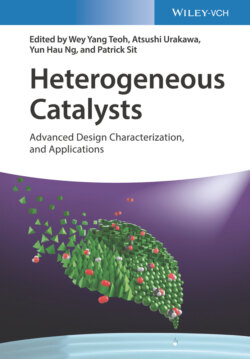Читать книгу Heterogeneous Catalysts - Группа авторов - Страница 38
3.2.3 Electrophoretic Deposition
ОглавлениеThe term “electrodeposition” is sometimes misused in representing the electrophoretic deposition as both processes involve the use of applied direct current. Electrodeposition is based on solution of ionic species, and the deposition is achieved when ionic reduction occurs. Electrophoretic deposition, on the other hand, is a colloidal processing method in which a suspension of particles in a solvent is used. The deposition is driven by the attraction (or repulsion) of charged particles to the charged electrodes using galvanostatic or potentiostatic condition. Both positively and negatively charged colloidal particles can be deposited using electrophoretic method. For positively charged particles, they are attracted to the negatively charged electrode (cathode), and there the deposition occurs on the cathode. This process is called cathodic electrophoretic deposition. Vice versa, when deposition of negatively charged particles takes place at positively charge electrode (anode), anodic electrophoretic deposition is the term. As the readers can imagine, if the surface charge on the particles can be tuned into positive or negative region, which is feasible by suitable surface modification, the particles can be deposited using either cathodic or anodic electrophoretic deposition. Figure 3.6 shows the schematic illustration of the two electrophoretic deposition processes.
Figure 3.6 Schematic illustration of electrophoretic deposition process: (a) cathodic electrophoretic deposition and (b) anodic electrophoretic deposition.
Unlike electrodeposition, the electrophoretic deposition does not require the liquid medium to be conductance, and in fact organic solvent is a preferred medium. Water is not an ideal medium in electrophoretic deposition because the applied voltage may cause the water splitting reaction that produces hydrogen and oxygen gases at the cathode and anode, respectively. The rigorous evolution of gases could adversely affect the formation of deposit on the electrodes. Because the deposition is greatly determined by the surface charge of particles, this technique offers versatility in depositing complex compounds and composites as long as surface charge can be modulated. One potential weakness, however, is the absence of particle and electrode reactions in electrophoretic deposition. The deposited materials do not lose their charge upon deposition, and therefore a reversal of electric field can result in delamination of the deposited layer. It is important to carefully select similarly charged particles and similar solvent–binder–dispersant systems for having good control over layer thickness.
As the mechanism of electrophoretic deposition involves movement of charged particles in liquid suspension driven by an applied voltage, the important parameters governing the deposition process are therefore related to the regulation of suspension and the physical parameters of the process (e.g. voltage, deposition time, etc.). For the suspension containing the targeted particles, many physicochemical natures of both particle and the liquid medium must be considered. Apparently, particle size suitable for electrophoretic deposition is an important factor. Although there is no general rule of thumb to specify ideal particle size for electrophoretic deposition, it is crucial to have a high dispersion and good colloidal stability to ensure even deposition. Colloidal particles with size smaller than 1 μm in diameter tend to remain in suspension stably owing to the Brownian motion. Therefore, in general, it is the main problem for larger particles as they tend to settle by gravity over shorter period. When the sedimentation of particles occur faster than the electrophoresis‐induced particles mobility, uniform deposition is unlikely: thinner coating on the top region while thicker deposit at the bottom of the substrate. However, this does not necessarily mean that large particles could not be deposited. Colloidal stability of large particle can be improved by having a very strong surface charge, and the electrophoresis movement can be increased with larger electrical double layer region.
Selection of liquid medium is another factor governing the quality of electrophoretic deposition. Dielectric constant of the liquid medium is highly correlated with the deposition performance. Deposition fails in the liquid medium with too low dielectric constant because of weak dissociative power, while electrophoretic mobility is significantly reduced when a medium with high dielectric constant is used due to the reduced size of double layer region. Consequently, liquids of low dielectric constant (but not too low) are a favorable condition. As mentioned earlier, stabilization of suspension, i.e. colloidal stability, is critical in facilitating smooth deposition, and this stability can be achieved by having high and uniform surface charge on the particle. The ζ potential of particle becomes one of the key factors in the electrophoretic deposition. The magnitude of the ζ potential determines the stability of the suspension (repulsive interaction between particles), while the polarity of the ζ potential (positively or negatively charge) decides the direction and migration velocity of the particles during electrophoretic process. The probability of coagulation of the suspended particle must be minimized by modulating the two forces with opposite effects: electrostatic and van der Waals forces. High electrostatic repulsion attributed to the high ζ potential (high particle charge) is desired to suppress agglomeration. Conveniently, the ζ potential can be tuned by carefully selecting pH and additives to the suspension.
